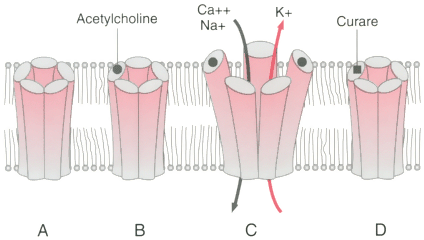Figure 22-6
The actions of acetylcholine or curare on end-plate receptors.
A, The ion channel is inactive and does not open
in the absence of acetylcholine. B, Even the binding
of one acetylcholine molecule (filled circle) to
one of two binding sites does not open the channel. C,
When acetylcholine binds to recognition sites of both α-subunits simultaneously
(filled circle), it triggers a conformation change
that opens the channel and allows ions to flow across the membrane. D,
The action of antagonists such as curare (filled square).
Acetylcholine is in competition with tubocurarine for the receptor's recognition
site but may also react with acetylcholinesterase. Inhibiting the enzyme increases
the lifetime of acetylcholine and the probability that it will react with a receptor.
When one of the two binding (recognition) sites is occupied by curare, the receptor
will not open, even if the other binding site is occupied by acetylcholine.

